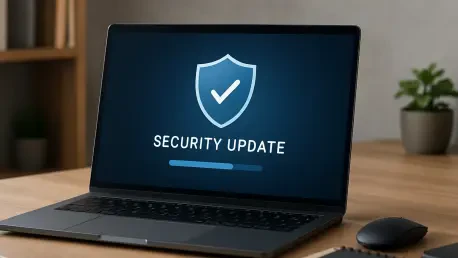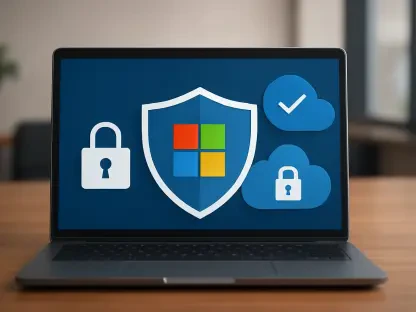In an era where cyber threats loom larger than ever, with global ransomware attacks costing enterprises billions annually, a single unpatched vulnerability can spell disaster for organizations relying on Microsoft systems. The November Patch Tuesday update, a monthly ritual for IT administrators, emerges as a vital shield against these escalating dangers. This review delves into the significance of this update, unpacking 63 patched vulnerabilities, including a zero-day flaw already under attack and a critical remote code execution bug that demands immediate attention. The stakes for enterprise security have never been higher, and understanding the depth of these fixes is essential for safeguarding critical operations.
Key Features of the November Security Update
Zero-Day Threat in Windows Kernel
The November update tackles a pressing zero-day vulnerability, identified as CVE-2025-62215, with a CVSS score of 7.5, affecting the Windows Kernel. This flaw, actively exploited in the wild, exploits a race condition to enable privilege escalation, allowing attackers with initial access to gain administrator-level control. Security experts highlight its role in post-exploitation scenarios, where it often pairs with other entry methods to deepen system compromise.
This vulnerability stands out as part of a troubling pattern, being one of several privilege escalation bugs in the Kernel addressed over recent months. Its active exploitation underscores the urgency for organizations to deploy patches swiftly, as delays could leave systems exposed to sophisticated attack chains that build on this flaw for broader network access.
Critical Remote Code Execution Flaw
Among the most alarming issues patched this month is CVE-2025-60724, a critical remote code execution (RCE) bug in the Windows GDI+ graphics component, carrying a near-perfect CVSS score of 9.8. This vulnerability allows zero-click exploitation through malicious metafiles uploaded to web services, posing a severe threat of arbitrary code execution or data theft without user interaction.
Despite Microsoft rating its exploitation as “less likely,” independent researchers express significant concern due to the widespread use of the GDI+ library across applications. The potential for attackers to weaponize this flaw in automated attacks makes it a top priority for patching, especially for environments handling web-based content or graphics processing.
High-Risk Kerberos Vulnerability
Another notable fix targets CVE-2025-60704, dubbed the “CheckSum” bug, a medium-severity flaw in Windows Kerberos with a CVSS score of 7.5. Affecting Active Directory environments with delegation enabled, this vulnerability opens the door to privilege escalation and lateral movement, potentially allowing attackers to impersonate domain administrators.
The global reach of Active Directory in enterprise settings amplifies the risk, as thousands of organizations could face network-wide breaches if exploited. Security analysts emphasize that even with its medium severity rating, the implications of this bug warrant immediate attention to prevent cascading damage across interconnected systems.
Additional Critical Fixes
Beyond the headline vulnerabilities, the update addresses several other high-impact flaws requiring urgent action. CVE-2025-62220, with a CVSS score of 8.8, affects the Windows Subsystem for Linux GUI, enabling RCE with minimal user interaction and posing risks in hybrid Windows-Linux environments.
Additionally, three bugs in the Windows Ancillary Function Driver for WinSock, each scoring a CVSS of 7.0, allow privilege escalation without user interaction, rated by Microsoft as highly exploitable. These diverse threats highlight the broad attack surface within Microsoft ecosystems, reinforcing the need for comprehensive patch management across all system components.
Performance and Impact Analysis
Recurring Patterns in System Weaknesses
Examining the broader context of this update reveals persistent challenges in Microsoft’s core components, particularly the Windows Kernel, which has seen multiple privilege escalation vulnerabilities patched in recent cycles. This recurring issue points to systemic complexities in kernel security that attackers continuously target for maximum impact.
The focus on foundational elements like GDI+ and Kerberos also reflects a strategic shift by threat actors toward exploiting widely used system libraries and protocols. Such vulnerabilities, when leveraged, can affect vast numbers of users and organizations, amplifying the potential for widespread disruption or data breaches in enterprise settings.
Enterprise Risks and Real-World Scenarios
For businesses, the implications of these unpatched flaws are stark, ranging from sensitive data theft to complete system takeover. Environments reliant on Active Directory face heightened risks from the Kerberos bug, where a single compromised credential could unlock extensive network access and enable lateral attacks.
Similarly, organizations with web services processing metafiles are prime targets for the GDI+ RCE flaw, where a malicious upload could silently execute harmful code. These real-world scenarios underscore the critical need for rapid patch deployment to protect business continuity and safeguard against financially crippling cyber incidents.
Patching Challenges in Operational Environments
Deploying these updates, however, is not without hurdles for many organizations. Operational downtime, compatibility concerns with existing software, and limited IT resources often delay patch application, leaving systems vulnerable during critical windows of exposure.
Moreover, discrepancies between Microsoft’s severity assessments and external expert warnings—particularly for flaws like the Kerberos bug—can create confusion in prioritizing fixes. The cybersecurity community continues to advocate for streamlined patching processes and better alignment of risk evaluations to address these practical barriers effectively.
Final Thoughts on the November Update
Reflecting on the November Patch Tuesday rollout, the urgency of the addressed vulnerabilities leaves a lasting impression on the cybersecurity landscape. The active exploitation of a zero-day Kernel flaw, coupled with a near-catastrophic GDI+ RCE bug and a deceptive Kerberos vulnerability, paints a vivid picture of the diverse threats targeting Microsoft systems. Moving forward, enterprises must adopt a proactive stance by prioritizing automated patch management tools to minimize delays and reduce exposure windows. Additionally, fostering collaboration between IT teams and security experts to reconcile differing severity assessments will be crucial in tackling understated risks. As cyber threats evolve, investing in robust backup strategies and incident response plans will serve as vital safeguards, ensuring resilience against potential exploits that slip through unpatched gaps.









